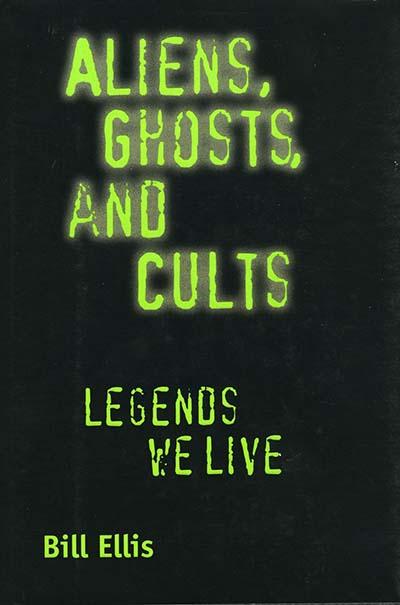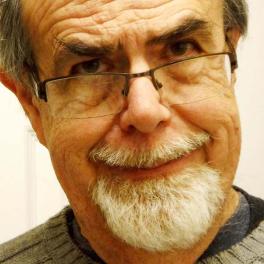Bill Ellis: Aliens, Ghosts, and Cults
Aliens, Ghosts, and Cults: Legends We Live by Bill Ellis is a groundbreaking work of scholarship that draws heavily on the OSU Folklore Archive's Student Ethnographic Projects collection (SEPs). It was published in 2001 by the University Press of Mississippi, whose summary of the book is as follows:
In late May, a Pennsylvania high school hums with the rumor that a Satanic cult plans on killing the first four couples through the door on prom night.

A horror writer in the Catskills is overcome with grief, alienated from his wife, unable to write, and suffering from recurring thoughts of physical and sexual indignities he has no words to describe. He concludes he has been abducted by aliens.
In a Pizza Hut in Ohio, employees refuse to close alone because the ghost of a hanged man haunts the refrigerator.
Tales such as these are the subject of Bill Ellis's Aliens, Ghosts, and Cults: Legends We Live. In the book, he explores the complex relationship between ordinary life and outlandish but oft-told legends. What he finds is startling. In multiple case studies legends become part of life. Officials take action in answer to each story's weird details, and people adjust their behavior to avoid or to experience aliens and ghosts.
Written for both the cultural studies expert and the reader fascinated with reactions to extraordinary phenomena, Aliens, Ghosts, and Cults pursues motivations for why people tell these "true stories, heard from a friend of a friend."
Ellis shows legends creating a sense of community in a multi-ethnic institutional camp. He traces some contemporary scares to such old tales as the vanishing hitchhiker and murderous gang initiations. In analyzing some newly emerging legend types, such as alien abductions and computer virus warnings, Ellis discovers connections between earlier types of religious experience and supposed witchcraft. Finally, the book reveals how legends can inspire people to actions, ranging from playful visits to haunted spots to horrifying threats of violence.
Legends rely on active discussion to spread and mutate. This book considers them to be a social process, not a kind of narrative with a fixed form. People worldwide may tell a legend or one person to whom the event allegedly occurred may "own" the story. Individuals may relate an event as something strongly believed or as something laughable. Legends may be very new or have roots in old folklore. But when high schools, law enforcement agencies, city governments, and individuals take action, the story becomes one of the legends we live.
Bill Ellis carried out much of his research for the book during and immediately following his time as a doctoral student in the English Department at The Ohio State University. In an interview conducted remotely on 19th November, 2021 - twenty years after the book was first published - Ellis spoke about the experience. (The interviewer was Rachel Hopkin and the excerpts from the interview quoted here have been edited.)
Once Ellis had completed his doctorate in 1978, he started to teach folklore classes to OSU undergraduates:
The undergraduates all had to do a collection project that would then become part of the Ohio State Folklore Archive. As these projects started coming in, I began finding out about a lot of adolescent folklore. So I got interested to see what else there would be in the Archive dealing with some of the legend trips in particular, such as the Gore Orphanage legend trip in the Cleveland area. I eventually wrote an essay on that which became part of Aliens, Ghosts, and Cults.
Access to the Archive was very restricted at the time. Its contents were not catalogued in any way and all the materials were kept in a storage room with a couple of shelves. There were a lot of cardboard boxes on the floor. As the projects came in, they were - at that time - really rather unceremoniously added to stacks of older undergraduate projects in the cardboard boxes in no particular order, except by instructor and by the order in which the class was given.

I learned my craft of doing research from Richard Altick - who was the grand old man of the English Department then - and he was very much a "pencil and paper" person. He taught us how to do “slips," which were blank sheets of paper that I could write notes to myself on. For example, I’d write “Gore Orphanage” on the top of a slip and I would – in pencil – take notes on what I’d found out. Nearly all of the research that went into Aliens, Ghosts, and Cults was done in that Altick pencil and paper research fashion with these slips that then you could file and refile and put in the order in which you wanted to discuss things and incorporate into the papers you were writing.
When I got permission to go in into the Archive, I’d take a stack of slips in and I'd go through these projects one by one. I learned to recognize some of the emic terms that students would use to refer to legend tripping. A lot of them were place names. “Cry Baby Bridge” was always a good bet for a legend trip. So was “Hatchet Lady." And there were others that I'd recognize. Sometimes the students would come up with kind of self-made scholarly categories like “folk ordeals.” but a lot of them would use the term “legend” as they'd learned enough to know that these were supernatural legends. There was no particular rhyme or reason to it, so that I often found myself writing on the title page of some of these early undergraduate projects what they were actually about as a guide to whoever came after me looking for relevant material.
Ellis remembered that at the time he was conducting his research - unlike today - there was no kind of "Finding Aide" to help him locate relevant material:
I had to go through the boxes one by one and I came up with a huge stack of legend trip material. It was an enjoyable time of my life because I never knew exactly what I was going to find in a given day. A lot of times, I would find not just good primary material, but really on-the-spot critical analysis of that material from the point of view of one member of that folk culture - i.e. the student – looking at another member’s description of a tradition. Some of the students’ insights were excellent and spot on in terms of the social implications of the tradition they were describing. That led me to developing this hypothesis in one of my early essays on legend tripping: that the important thing about the legend trip was not the legend, but the trip. The trip was a journey outside of consensus every day boring life into something that was potentially paranormal, or supernatural, or – at the very least – dangerous, and was likely to generate a new worldview if you participated in it. I ended up arguing that it was similar in some ways to drug tripping, which was popular at the time. It was a behavioral way of generating a kind of spirit quest that allowed you to put yourself in some place that you could convince yourself was not part of the every day and where you could challenge the Other world to come and meet you.
Using the Folklore Archive presented Ellis with some ethical challenges:
There was always the ethical issue about how to use material that seemed private, particularly when you were dealing with stories in which people were sharing very intimate feelings, religious feelings, or personal existential feelings about what – if anything – the existence of ghosts proved. For some of the material, I really felt that the clearance that had been obtained by the students from their informants was rather slim. A lot of times, I would say, “in the interests of the parties involved, I've given the informants and the names of the places mentioned false names" so as to avoid any risk of causing embarrassment to the original contributors. I did that with the Pizza Hut ghost story which is in Aliens, Ghosts, and Cults, I disguise the name of the town in which the Pizza Hut existed, and I did not give the name of the informant or the names of the people that were mentioned by the informant.
Ellis stated that the initial reaction to the book was muted, but appreciation has grown over time:
The marketing team of The University Press of Mississippi was skeptical about whether the book would sell. I’d titled it Friend of a Friend, but they wanted something that would make someone pick it up and start to browse, so they insisted on the title Aliens, Ghosts, and Cults. When I’d sign a copy for a friend, I’d always write “Oh my!” under the press’s title. But their strategy seems to have worked, for the book sold out in hardback, and went to on-demand paperback after a very few years. And, increasingly, the paperback edition has been used in classes. I'll occasionally get a query from a student who has read one of the essays, asking some pertinent questions about it. Sometimes people will - out of the blue - mention an essay in there as "a classic." They are often surprised to hear that when it was first presented or published, the original audience was often deeply puzzled or even hostile to the idea of such material being discussed as folklore. So when I learn that my work is now being read and commented on, I know that the academic folklore field is changing.
In summation, I'm happy that the book has called attention to a lot of material that wasn't really being looked at very closely at the time. I think it's had a positive influence in attracting people to new forms of folklore. I'm very pleased that the New Directions in Folklore section of the AFS named their annual prize after me, because that's a lot of what I did in my career, I was saying, “here's something new. Why aren't folklorists looking at it? This is obviously part of our purview.”
Ellis remains a strong supporter of the OSU Folklore Archive:
It's primary material. It's what folklorists ought to be basing their interpretations on. I've always been a stickler for that, because if you don't have data to back up a conclusion that you're making, what you're doing is simply spinning out a personal evaluation. It seems to me that this kind of primary data too often has been, and I think still is, not valued by a lot of folklorists, who are trying to make rather grand theories and interpretations about the nature and the significance and the function of folklore. To me, the value of the Ohio State Folklore Archive is that it contains the primary stuff that needs to be winnowed through in order to build a foundation for understanding what folklore is and why it is such an integral part of human society. I do feel for the people who are dealing with the Archive, though, because moving from typed pages to something that is browsable, searchable … that's a real need for any archive. I really wish the best because I think there's solid gold there - the primary stuff that folklorists ought to be grappling with.
